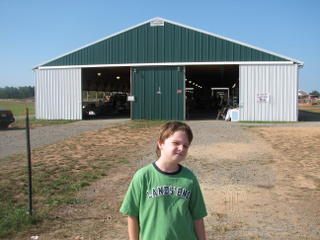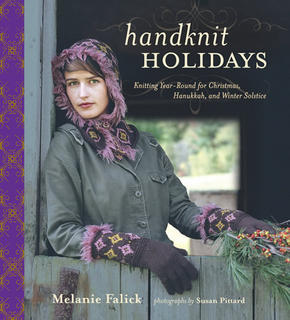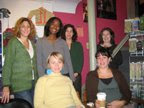
Here are the specs: It's maybe 42" long and about 10" wide. I used Jaggerspun Zephyr, which is 50% silk and 50% merino wool and about 5000 yards per pound. "Yards per pound," or ypp, is weaver-talk for yarn weight. In this case, it means "pretty darn skinny," as in, US #2 needles and a gauge of about 10 sts per inch.
I bought the yarn at Stitches East (which back then was just called Stitches) in about 1992. It was the same year I took a workshop with Susie Hodges on knitting fairisle patterns two-handed--that is, one strand in the left and one strand in the right. Sandy Terp, of Moonrise Designs, was selling little bits and pieces of Zephyr tied together on strings--maybe half an ounce of each of 5 or 6 colors for $5. I bought two, both in the blue/green family.
I used a 16" circular needle and cast on something like 160 sts (or it may have been 180*), and began knitting in the round. I had also bought a used copy of Alice Starmore's Book of Fair Isle Knitting, which is my favorite fairisle book, specifically because of the pattern library chapter. It has dozens and dozens of charted patterns, sorted into groups based on size--single-row patterns, two-row patterns, etc., on up to large snowflakes and stars. I started playing with the smaller border patterns and the colors I had. At 20" or a little before, I decided that I wanted to use each pattern only once. Within 4", I made a mistake, and reused a pattern that I'd used only a few inches before--an incredibly simple pattern, at that. I didn't realize until much later, and I sure wasn't going back.
The patterns fell into a rhythm: a very narrow pattern, then a medium-width pattern, then another very narrow one, then a slightly larger one--then repeat. Progress was not especially swift. By about February, I realized that I was running out of the color I liked best. I wrote to Sandy and enclosed a snip of the yarn--remember, these windings didn't even have labels--and she sent me more. I kept going.
I tried to finish the scarf in time for the next Stitches, in the hope of showing it to Susie Hodges, but I missed. She still liked it on the needles. I finished it the following night by staying up until morning and deciding that where I was was long enough. I bound off, then flattened the tube with the round-beginning at one edge, and sewed the top and bottom edges shut. Presto! No need to weave in 100,000 ends.
The scarf is very soft and very warm. I don't know any other yarn that's fine enough for this job--remember, the fairisle patterning makes the fabric almost twice as thick as single-color, and the tube doubles the thickness again, and the finished thing has to go around the neck without strangling the wearer--that has anything like this color range. There aren't many projects I've made that I'm just about totally satisfied with. This is one.
And that's the story of the Zephyr scarf.
*I'm guessing here, because the scarf is at home and I'm not. 160 or 180 was chosen because it had so many good factors--that is, a 4-stitch repeat would work, a 6-stitch repeat would work, etc.










